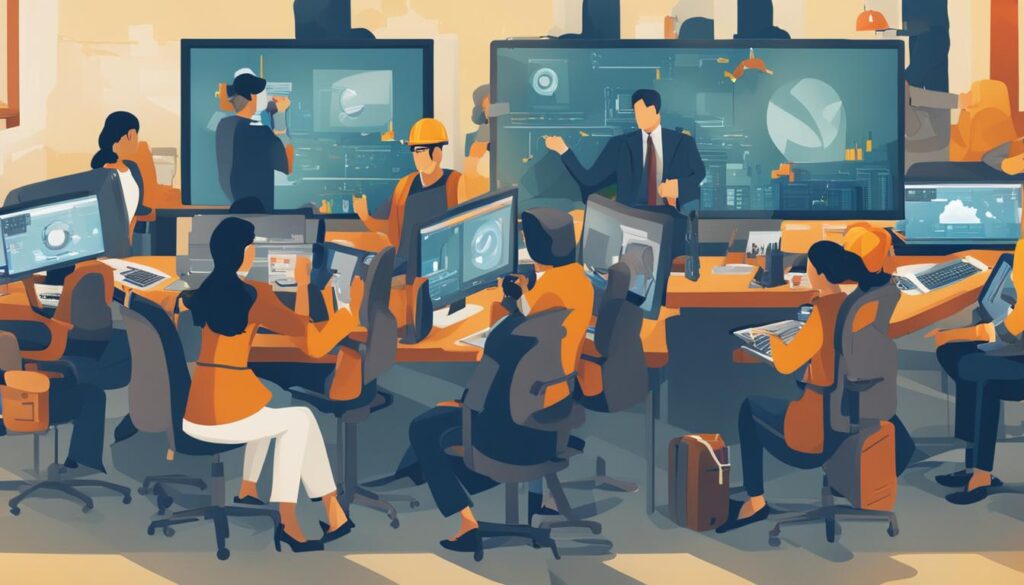Technology has transformed our lives in countless ways, revolutionizing the way we work, communicate, and access information. However, as we embrace the benefits of information technology, there is a growing concern about its impact on the middle class. Many wonder if the rise of technology is leading to the destruction of middle class jobs and widening income inequality. Let’s explore some of the key aspects and complexities surrounding the relationship between information technology and the middle class.
Contents
- 1 The Impact of Automation on Middle Class Jobs
- 2 Technology and Income Inequality
- 3 The Future of Middle Class Jobs
- 4 Conclusion
- 5 FAQ
- 5.1 Is information technology destroying the middle class?
- 5.2 What is the impact of automation on middle class jobs?
- 5.3 How does technology contribute to income inequality?
- 5.4 How does the digital divide impact the middle class?
- 5.5 What is the future of middle class jobs in the face of technological advancements?
- 6 Source Links
Key Takeaways:
- In the age of information technology, the middle class faces challenges and uncertainties regarding job security and income stability.
- Automation and technological advancements have led to a decline in middle-skill jobs, polarizing employment opportunities.
- The rise of technology has contributed to income inequality, with high-skilled workers benefiting more than middle-skill workers.
- Access to technology and digital skills are becoming essential for job prospects and income, creating a digital divide that can affect the middle class.
- The future of middle class jobs will depend on how individuals and society adapt to the changing technological landscape and prioritize education and skills training.
The Impact of Automation on Middle Class Jobs
Technological advancements, particularly automation, have had a significant impact on middle class jobs. With the rise of automation, routine tasks that can be easily automated are being taken over by computers and machines. This has resulted in a decline in middle-skill jobs and a transformation in the job market.
“Automation is reshaping the employment landscape, causing disruption to traditional middle class jobs.”
As a result of automation, there has been a polarization of employment. Job growth is now concentrated in two major sectors: high-wage professional and technical occupations and low-wage service occupations. Middle class jobs, which used to provide a stable income for many individuals, are diminishing, leading to a decline in the middle class.
The middle-class jobs that do remain often require a combination of routine technical tasks and nonroutine tasks that cannot be easily automated. This means that the nature of middle class work is changing, requiring individuals to adapt and acquire new skills. The middle class is facing a technological revolution, and it is crucial for individuals to develop a versatile skill set that can keep up with the demands of the evolving job market.
The Changing Landscape of Middle Class Employment
The impact of automation on middle class jobs can be visualized through the following table:
| Before Automation | After Automation | |
|---|---|---|
| Job Availability | Abundant middle-skill jobs | Declining middle-skill jobs |
| Job Roles | Routine technical tasks | Combination of routine and nonroutine tasks |
| Income Level | Stable middle class income | Decreasing middle class income |
https://www.youtube.com/watch?v=mBoSJpRm7gk
As shown in the table, automation has led to a decline in middle-skill jobs, resulting in a decrease in job availability and incomes for the middle class. This not only affects individuals and their families but also has broader implications for the overall economy and society.
It is important for individuals to recognize the impact of automation on middle class jobs and take proactive steps to adapt to the changing employment landscape. Acquiring new skills, embracing technological advancements, and pursuing opportunities in high-wage professional and technical occupations are crucial for staying relevant in today’s technology-driven world.
While automation poses challenges for the middle class, it also opens up new possibilities and opportunities for growth. Through innovation and a proactive approach to reskilling and upskilling, individuals can navigate the technology revolution and secure their place in the evolving job market.
Technology and Income Inequality
The rise of technology has had a significant impact on income inequality, with both positive and negative consequences for different segments of the population. While highly educated workers who excel in abstract tasks have benefited from technological advances, middle-skill workers in routine job roles have faced challenges, including a decline in job opportunities and wages.
The advancements in technology have led to the automation of many routine tasks that were previously performed by middle-class workers. As a result, these jobs have been replaced by computers and machines, leading to job losses and decreased job security for the middle class. This has contributed to a growing income gap between high-wage and low-wage workers, further squeezing the middle class.
The impact of technology on income inequality can be understood by exploring the polarization of employment. On one end, there is job growth in high-wage professional and technical occupations that require advanced skills and expertise in utilizing technology. These occupations have seen an increase in demand and offer higher wages, benefiting those with the necessary qualifications.
On the other hand, low-wage service occupations have also seen an increase in job opportunities, as there is a need for human interaction and tasks that cannot be easily automated. However, these jobs often come with lower wages, limited benefits, and a lack of job security.
The middle class, which traditionally consisted of workers in routine job roles, has been caught in the middle. As technology advances and automation continues, these middle-skill jobs are rapidly disappearing, leading to income stagnation and a decline in the overall well-being of the middle class.
In essence, the technological advancements have widened the gap between those who have the skills to adapt to the changing landscape and those who don’t. The middle class, once considered the backbone of society, is facing increased challenges in maintaining their socioeconomic status.

| Impact of the Digital Divide on the Middle Class | Solutions for Bridging the Divide |
|---|---|
| Limitations in job opportunities and income growth | Improving access to affordable internet |
| Lack of digital skills hindering career progression | Expanding digital literacy programs |
| Income inequality due to differential access to technology | Providing devices and digital tools at affordable prices |
| Restricted access to online educational resources | Enhancing broadband infrastructure in underserved areas |
By addressing the digital divide and ensuring equal access to technology and digital skills, we can help the middle class thrive in the ever-evolving digital landscape and secure meaningful employment opportunities in the tech industry.
The Future of Middle Class Jobs
The rapid advancements in technology have raised concerns about the future of middle class jobs. While technological progress has the potential to create new industries and employment opportunities, there is also a growing fear that it may result in job loss for many middle class workers.
Automation, artificial intelligence, and other technological advancements have already started to replace human workers in various industries. Tasks that were once performed by middle class workers are now being automated, leading to a decline in job opportunities and potential income for those in middle skill occupations.
However, it is important to note that technology not only eliminates jobs, but it also creates new ones. As industries evolve and adapt to technological advancements, new roles and sectors emerge, offering job opportunities to those who possess the right skills and knowledge.
To secure a future in the middle class job market, it is crucial for workers to adapt and acquire skills that are in demand. Upskilling and reskilling efforts play a pivotal role in ensuring that individuals can thrive in the technology-driven economy.
Educational institutions, vocational training programs, and businesses should collaborate to provide workers with the necessary training and resources to enhance their skills and stay relevant in the job market. By acquiring skills that are difficult to automate, such as critical thinking, creativity, problem-solving, and emotional intelligence, individuals can position themselves for higher-paid jobs that are less likely to be replaced by technology.
It is also essential for workers to stay updated on technological advancements and industry trends. Keeping abreast of the latest developments and acquiring digital literacy skills will help individuals remain competitive in the job market.
The future of middle class employment hinges on the ability of workers to adapt, upskill, and embrace technological advancements. By staying ahead of the curve and continuously learning, individuals can secure their place in the technology-driven workforce.
The Role of Education and Government Policies
Educational institutions play a vital role in preparing the future middle class workforce. By providing comprehensive education that emphasizes both technical skills and critical thinking abilities, educational institutions can equip students with the tools they need to succeed in the evolving job market.
Government policies also play a crucial role in shaping the future of middle class employment. By investing in infrastructure, research and development, and promoting innovation, governments can foster an environment that encourages the growth of industries and the creation of new jobs.
Conclusion
The impact of technology on the middle class is a topic that warrants careful consideration. While it has undoubtedly caused job polarization and income inequality, it has also created new avenues for success in high-wage technical occupations. The future of middle class jobs will ultimately depend on how society and individuals adapt to the ever-evolving technological landscape.
To ensure that the middle class can navigate the challenges and opportunities presented by technology, it is crucial to address the digital divide. Access to technology and the acquisition of digital skills are becoming increasingly important for job prospects and income. Investing in education and skills training will be essential in closing this divide and equipping the middle class with the tools they need.
The middle class must be proactive in upskilling and reskilling to remain relevant in the job market. With the rapid advancements in technology, there is a concern that certain roles may be replaced by automation. By continuously acquiring new skills that are in demand, the middle class can position themselves for success in the technology-driven economy.
While there are challenges posed by the impact of technology on the middle class, there is also a glimmer of hope. By embracing the changes and adapting accordingly, the middle class can capitalize on the opportunities that arise. With the right investments in education, skills development, and bridging the digital divide, the middle class can navigate the technological landscape and thrive in the ever-changing job market.
FAQ
Is information technology destroying the middle class?
The impact of information technology on the middle class is complex. While it has led to job polarization and income inequality, it has also created new opportunities in high-wage technical occupations.
What is the impact of automation on middle class jobs?
Automation has led to a decline in middle-skill jobs and a polarization of employment. Routine tasks that can be easily automated are being replaced by computers and machines.
How does technology contribute to income inequality?
Technological advances have benefited highly educated workers in abstract tasks but have resulted in a decline in job opportunities and wages for middle-skill workers in routine job roles.
How does the digital divide impact the middle class?
The digital divide can impact the middle class by creating disparities in access to technology and digital skills, which are becoming essential for job prospects and income.
What is the future of middle class jobs in the face of technological advancements?
The future of middle-class jobs is uncertain. While new industries and jobs may be created, there is concern that technology will continue to replace human workers.
Source Links
- https://opinionator.blogs.nytimes.com/2013/08/24/how-technology-wrecks-the-middle-class/
- https://www.brookings.edu/wp-content/uploads/2019/11/Siu_Jaimovich_Automation-and-the-middle-class.pdf
- https://www.jacksonville.com/story/news/nation-world/2013/01/28/ap-investigation-technology-killing-millions-middle-class-jobs/15840097007/




